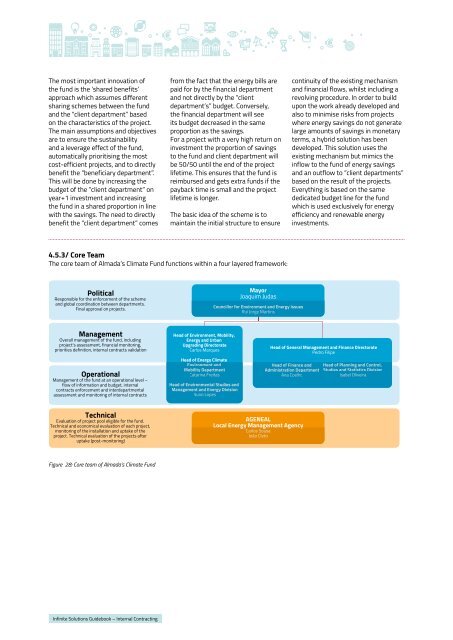Contracting
guidebook_intracting_web
guidebook_intracting_web
Create successful ePaper yourself
Turn your PDF publications into a flip-book with our unique Google optimized e-Paper software.
The most important innovation of<br />
the fund is the ‘shared benefits’<br />
approach which assumes different<br />
sharing schemes between the fund<br />
and the “client department” based<br />
on the characteristics of the project.<br />
The main assumptions and objectives<br />
are to ensure the sustainability<br />
and a leverage effect of the fund,<br />
automatically prioritising the most<br />
cost-efficient projects, and to directly<br />
benefit the “beneficiary department”.<br />
This will be done by increasing the<br />
budget of the “client department” on<br />
year+1 investment and increasing<br />
the fund in a shared proportion in line<br />
with the savings. The need to directly<br />
benefit the “client department” comes<br />
from the fact that the energy bills are<br />
paid for by the financial department<br />
and not directly by the “client<br />
department’s” budget. Conversely,<br />
the financial department will see<br />
its budget decreased in the same<br />
proportion as the savings.<br />
For a project with a very high return on<br />
investment the proportion of savings<br />
to the fund and client department will<br />
be 50/50 until the end of the project<br />
lifetime. This ensures that the fund is<br />
reimbursed and gets extra funds if the<br />
payback time is small and the project<br />
lifetime is longer.<br />
The basic idea of the scheme is to<br />
maintain the initial structure to ensure<br />
continuity of the existing mechanism<br />
and financial flows, whilst including a<br />
revolving procedure. In order to build<br />
upon the work already developed and<br />
also to minimise risks from projects<br />
where energy savings do not generate<br />
large amounts of savings in monetary<br />
terms, a hybrid solution has been<br />
developed. This solution uses the<br />
existing mechanism but mimics the<br />
inflow to the fund of energy savings<br />
and an outflow to “client departments”<br />
based on the result of the projects.<br />
Everything is based on the same<br />
dedicated budget line for the fund<br />
which is used exclusively for energy<br />
efficiency and renewable energy<br />
investments.<br />
4.5.3/ Core Team<br />
The core team of Almada’s Climate Fund functions within a four layered framework:<br />
Political<br />
Responsible for the enforcement of the scheme<br />
and global coordination between departments.<br />
Final approval on projects.<br />
Mayor<br />
Joaquim Judas<br />
Councillor for Environment and Energy Issues<br />
Rui Jorge Martins<br />
Management<br />
Overall management of the fund, including<br />
project’s assessment, financial monitoring,<br />
priorities definition, internal contracts validation<br />
Operational<br />
Management of the fund at an operational level –<br />
flow of information and budget, internal<br />
contracts enforcement and interdepartmental<br />
assessment and monitoring of internal contracts<br />
Head of Environment, Mobility,<br />
Energy and Urban<br />
Upgrading Directorate<br />
Carlos Marques<br />
Head of Energy Climate<br />
Environment and<br />
Mobility Department<br />
Catarina Freitas<br />
Head of Environmental Studies and<br />
Management and Energy Division<br />
Nuno Lopes<br />
Head of General Management and Finance Directorate<br />
Pedro Filipe<br />
Head of Finance and<br />
Head of Planning and Control,<br />
Administration Department<br />
Studies and Statistics Division<br />
Ana Coelho<br />
Isabel Oliveira<br />
Technical<br />
Evaluation of project pool eligible for the fund.<br />
Technical and economical evaluation of each project,<br />
monitoring of the installation and uptake of the<br />
project. Technical evaluation of the projects after<br />
uptake (post-monitoring)<br />
AGENEAL<br />
Local Energy Management Agency<br />
Carlos Sousa<br />
João Cleto<br />
Figure 28: Core team of Almada’s Climate Fund<br />
CITY GENERAL<br />
BUDGET<br />
financial<br />
management<br />
FINANCIAL<br />
SERVICE<br />
approved actions<br />
approved savings<br />
financial resources<br />
financial<br />
management<br />
Infinite Solutions Guidebook – Internal <strong>Contracting</strong><br />
financed<br />
actions<br />
CITY<br />
COUNCIL<br />
REVOLVING<br />
FUND<br />
technical<br />
management<br />
efficiency<br />
city budget<br />
proposal<br />
saving<br />
evaluation<br />
proposals<br />
WG for<br />
CITY BUDGET<br />
DEFINITION<br />
saving<br />
evaluation<br />
proposals<br />
ENVIRONMENTAL<br />
POLICIES<br />
AGENCY<br />
performance<br />
data<br />
action<br />
budget<br />
porposals<br />
“CUSTOMER”<br />
INTERNAL UNIT<br />
proposals of<br />
actions to be<br />
financed<br />
through<br />
the fund


